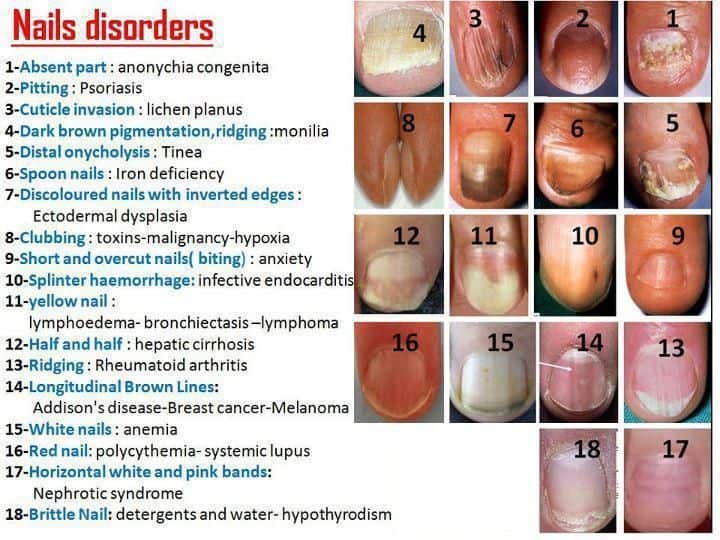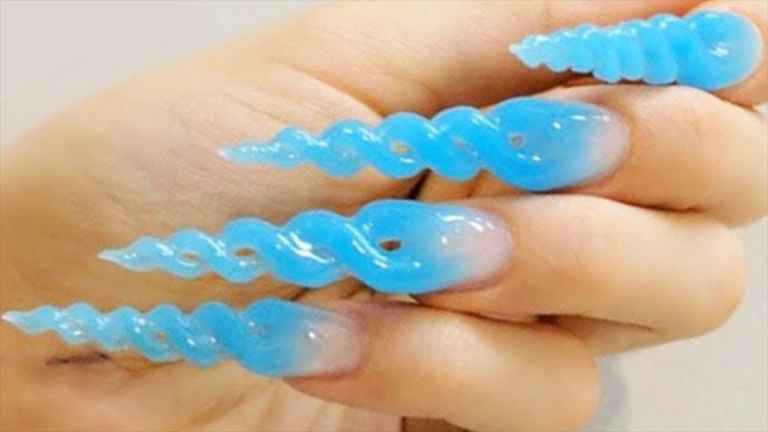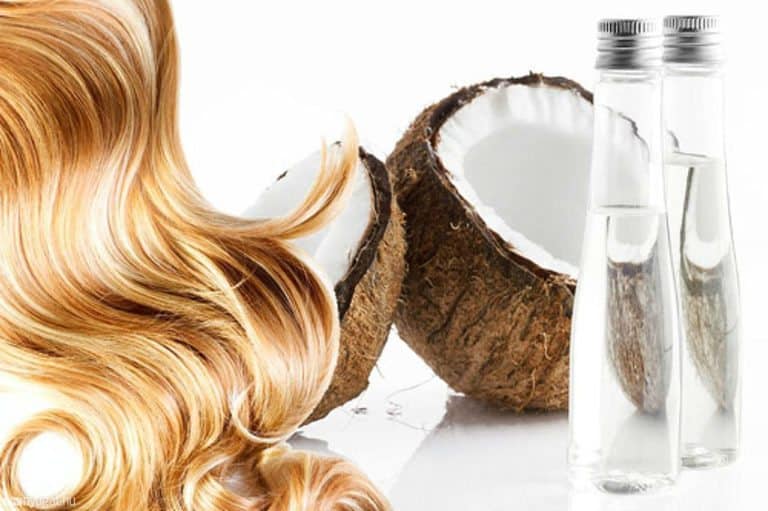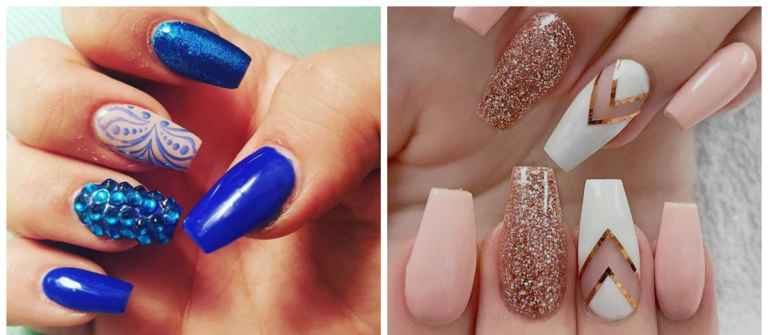What are Fingernail and Toenail Abnormalities?
What are fingernail and toenail abnormalities? Nail abnormalities can be a range of things that are different about your nail than usual. Read below to discover some nail abnormalities.
Everyone has had healthy fingernails and toenails at one point in their life but sometimes our health changes, and so do our nails. Healthy fingernails and toenails are smooth-looking and have consistent coloring, and it is okay for our nails to become brittle and have ridges as we get older but not too brittle. We sometimes incur spots and lines in our nails from injuries, but those usually grow out and are normal.
What are fingernail and toenail abnormalities? Some abnormalities are spots, discoloration, nail separation, viral warts, infections, and other things that doctors will use to diagnose what you have. The way our nails looks sometimes cannot tell us what is wrong with us and additional test needs to be done by doctors such as a physical exam and bloodwork to make a diagnosis.
Nail disease is a serious issue that affects many individuals physically, socially, or physiologically.
What are fingernail and toenail abnormalities?
Types of abnormalities of the fingernail
It is suggested that everyone consult your doctor if your nail/nails change and you feel there is something wrong with your nail. Sometimes our nails change because of medical conditions that need a doctor. We suggest that you should see a doctor if you have any of the conditions below.
- Brittle nails
- Discoloration of your nails – dark streaks, white streaks, or nail color changes
- Bleeding from/around your nails
- Your nail gradually changing shape – curling or clubbing.
- The area around your nail pains
- Pitted nails
- The thickness of your nails changes to either thickening or thinning.
- The area around your nail swells, or redness occurs.
- The nails start to separate from the skin. The above changes in your nails can occur for various reasons, including some of the conditions below. How to Grow Long Strong Nails at Home
-
Clubbing
Clubbing is also known as D. Hamman-Rich syndrome (acute interstitial pneumonitis) and is when your nails curve and thicken around your fingertips which can take several years.
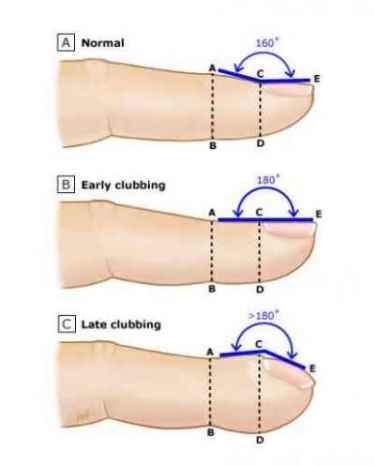
What is the clubbing of fingers? Photo source: UptoDate Clubbing can occur when we have low oxygen in our blood and is associated with:
- Various underlying cardiovascular disorders
- Inflammatory bowel disease
- Neoplastic disease
- Hepatobiliary disease
- Infectious disease
- Mediastinal disease
- Gastrointestinal disease
- Endocrine disease
- Liver diseases
- Various underlying pulmonary disorders
- AIDS
-
Distal Subungual Onychomycosis

Can onychomycosis be painful? Photo source: KellyPangNail Onychomycosis is an infection of fingernails and toenails that are difficult to treat and can reoccur after being treated. Oral terbinafine and itraconazole penetrate deep into the nail bed and nail matrix, helping to manage Onychomycosis.
Onychomycosis can cause pain, discomfort, disfigurement, functional limitations, reduce the quality of your nail, and cause severe physical limitations.
Fluconazole and posaconazole are not approved by the Food and Drug Administration (FDA) for onychomycosis therapy, so alternative medication is terbinafine and itraconazole.
-
Mees’ Lines
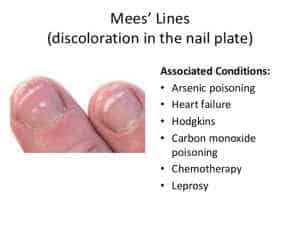
Small white lines on nails Photo source: Slideshare Mees’ lines are also called Aldrich–Mees’ lines and leukonychia striata, white lines in/on your fingernails or toenails. The white line tends to disappear as your nails grow and as you trim your nails.
Mee’s lines can be associated with poisoning (arsenic, thallium, or heavy metals), renal failure and have been seen in chemotherapy patients.
-
Pitting
Pitting are small little pits, indentation (shallow or deep), or depression marks on your nails. Sometimes the pitting looks like white spots or other marks on your nails.
Nail pitting is a defective development of the layers in the nail plate, and about 50% of psoriasis patient has this condition. Some people have nail discoloration, nail thickening, or/and abnormal growth with their nails when they have pitting.
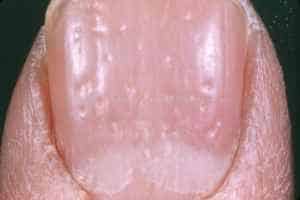
What causes pitting of the fingernails? Photo source: Quora Nail pitting is typical in people over age 40 and in individuals who have psoriatic arthritis.
Nail pitting can be associated with Connective tissue disorders, including Reiter’s syndrome, Osteoarthritis, autoimmune diseases (alopecia areata, sarcoidosis, and pemphigus Vulgaris), Incontinentia pigmenti, atopic and contact dermatitis.
Some doctors will suggest corticosteroid injections into your nail beds or for you to take vitamin D3, but it will be a long process.
- Yellow nail syndrome
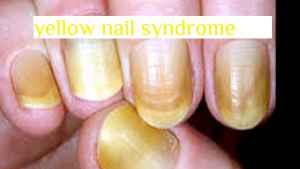
What are the causes of yellow nails? Photo source: Youtube Yellow nail syndrome is also known as primary lymphedema, and it is a sporadic medical syndrome associated with yellow nails, chronic sinusitis, persistent coughing, and pleural effusion. People are usually diagnosed with this syndrome if they have 2 of 3 of the following conditions: yellow nails, lymphedema, and/or lung problems.
Yellow nail syndrome is when your nail does not grow as fast as it usually does, gets thicker than usual, the nail does not have a cuticle, and sometimes when the nail cuticle pulls away from the nail bed.
Yellow nail syndrome is also associated with some drugs, including penicillamine, bucillamine, and gold sodium thiomalate.
Vitamin E is suggested to treat yellow nail syndrome and medicine that addresses swelling and respiratory problems.
-
Beau’s lines
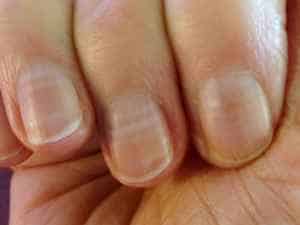
What does it mean if you have a black line on your fingernail? Photo source: Rocquieslymphoma Beau’s lines are depressions, ridges, indentation, or grooved lines that are across (from side to side) your fingernail. Those lines can signify malnourishment, measles, mumps, scarlet fever, peripheral vascular, zinc deficiency, disease, pneumonia, and uncontrolled diabetes.
Beau’s lines can be caused by a cessation of cell division in the nail matrix, infection, a problem where the nail begins to form, or the nail fold, and might also be an injury to that area on your nail.
A few other causes can be coronary occlusion, malnutrition, skin disease, drugs used in chemotherapy, hypocalcemia, and systemic disease.
-
Koilonychia
Koilonychia is also known as spooning nails and is when your fingernails are fragile, have raised ridges, or extraordinarily flat, and scoop outward resembling a spoon.
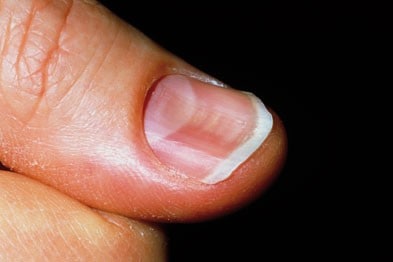
What does it mean when your fingernails are spoon-shaped? Photo source: NAilsjournal Spooning nails can be associated with iron deficiency (anemia), heart disease, psoriasis, hemochromatosis, lupus erythematosus, lichen planus, hypothyroidism, and Raynaud’s disease.
Iron deficiency can also be associated with not consuming/intaking enough iron in your meals, your body not being able to absorb iron adequately, malnutrition, intestinal bleeding, cancer, and celiac disease.
Early signs that your nail might be in danger are when your nails are brittle and chips and break easily.
-
Leukonychia (white spots)
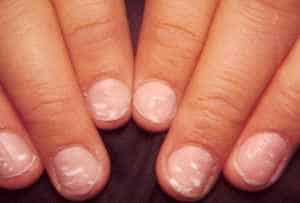
What are the white half circles on your nails? Photo source: WebMD White spots or lines that are nonuniform on the nail are sometimes from certain drugs, minor trauma, poor health, systemic diseases, and nutritional deficiencies.
White spots might also be associated with arsenic poisoning, renal failure, hepatic cirrhosis, pneumonia, lead poisoning, zinc deficiency, iron deficiency, protein deficiency, heart disease, and ulcerative colitis.
The eight what are fingernail and toenail abnormalities? Above are just some of the signs we should be aware of, but those signs are not proof that you have a medical condition. Please visit your doctor if you have any questions or concerns.
Source: Healthline.com, Medicinenet.com, medicinenet.com, Pinterest.com
